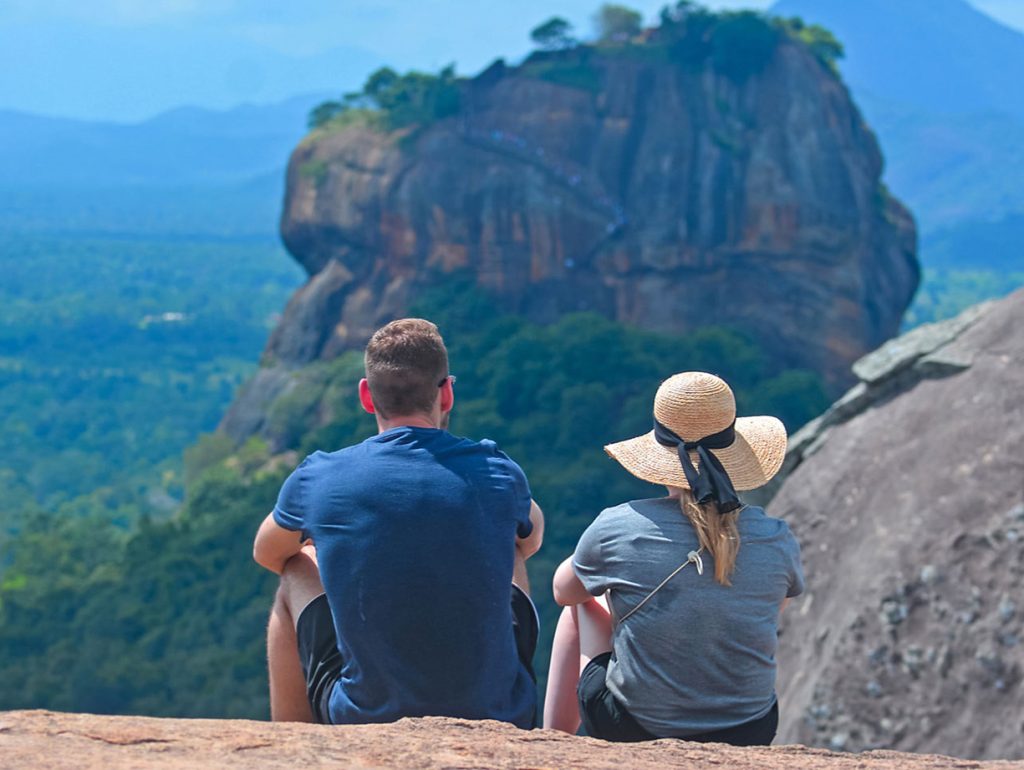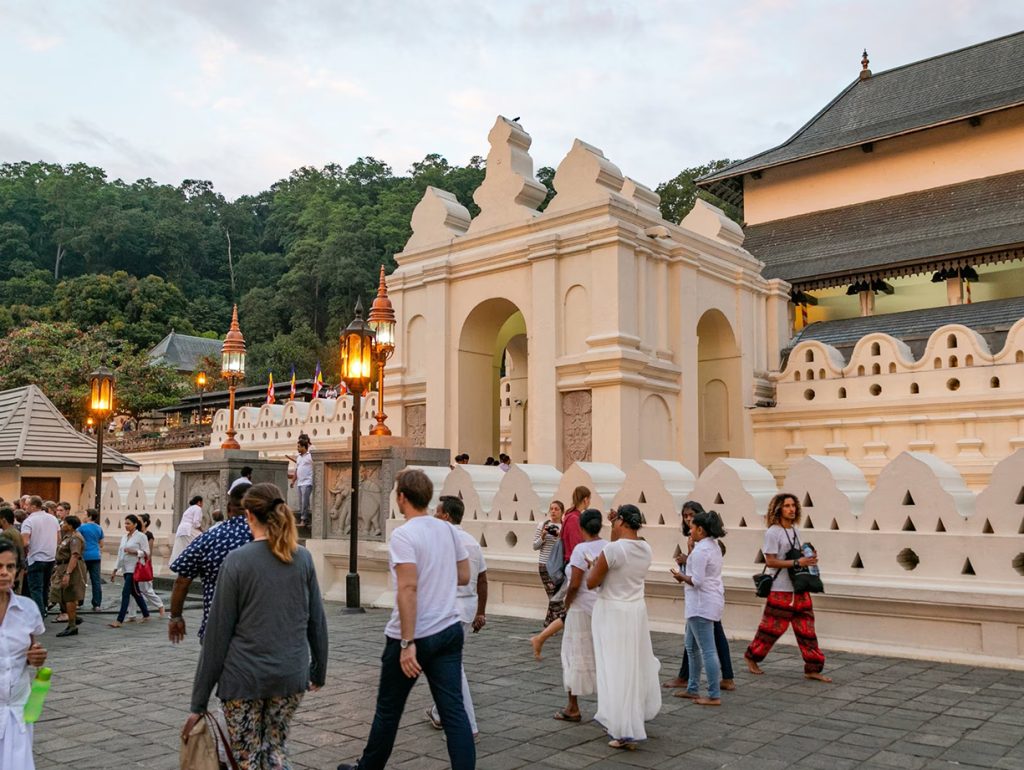If you’re backpacking through Sri Lanka, you can discover the island’s versatility in a relatively short time. It’s no wonder that this beautiful island in the Indian Ocean is hugely popular among travelers. We’ll provide you with tips for your 2-3 week tour of Sri Lanka, with an itinerary covering all the country’s highlights.
Places to visit during your 3-week Sri Lanka tour
There are several highlights in Sri Lanka that you don’t want to miss during your 3-week tour. To visit these, you can choose multiple places as bases and plan your route accordingly. A good itinerary for a 3-week tour of Sri Lanka might look something like this:
Negombo – Arrival and beach
Dambulla – Sigiriya (also known as Lion Rock) and/or Pidurangala Rock, cave temples, ancient city of Polonnaruwa
Optional: Minneriya National Park – Elephant safari
Kandy – Temple of the Tooth, botanical gardens, train journey to Ella
Optional: Nuwara Eliya (Little England) – Tea plantations, train journey to Ella
Ella – The town itself, hike to Little Adam’s Peak or Ella Rock, tea plantations
You can travel around Sri Lanka by train, taxi, tuk-tuk, or a combination thereof.
The ideal itinerary for a 2 or 3-week Sri Lanka tour:
Sri Lanka is an island, making it very easy to plan an itinerary for your 2 or 3-week tour. Although it depends on the time you have available, the basic idea is to travel in a loop. At the start of your trip, it’s important to decide: clockwise or counterclockwise? Both have their own advantages and disadvantages.
Clockwise: Ending at the beach in the south during your 3-week Sri Lanka tour
Most backpackers traveling in Sri Lanka go clockwise. You start with culture, travel through the famous train journey through the tea plantations to the mountains, and end your Sri Lanka tour at the beach. In between, you discover Sri Lanka’s wildlife in one of the national parks. The advantage of this Sri Lanka tour is that you end your vacation at the beach. You also get a varied impression of the country right at the start of your trip, which will undoubtedly leave a good first impression. If you’re making a shorter tour, such as a 2-week Sri Lanka tour, this route might be the best choice.
Clockwise: Ending at the beach in the south during your 3-week Sri Lanka tour
Most travelers backpacking in Sri Lanka travel clockwise. You start with culture, travel via the famous train journey through the tea plantations to the mountains, and end your Sri Lanka tour at the beach. In between, you discover Sri Lanka’s wildlife in one of the national parks. The advantage of this Sri Lanka tour is that you end your vacation at the beach. You also get a varied impression of the country right at the start of your trip, which will undoubtedly leave a good first impression. If you’re making a shorter tour, such as a 2-week Sri Lanka tour, this route might be the best choice.
Start your 2-3 week Sri Lanka tour in Negombo
A logical start for your 2 or 3-week Sri Lanka tour seems to be the capital Colombo. Your flight ticket indicates that you arrive here. And that’s true, but Negombo is actually much closer to the airport and has a beach: this is a much nicer place to recover from the long flight than the bustling city of Colombo. Additionally, Colombo doesn’t have a huge number of highlights, which you can easily visit at the end of your Sri Lanka tour. Many travelers therefore choose to stay in Negombo at the beginning of their 3-week Sri Lanka tour. But you don’t have to stay here long either. I recommend moving on as soon as possible, so you have more time for the nicer parts of the country.
Dambulla
After arriving in Sri Lanka, a logical next place to stay is somewhere in the vicinity of Dambulla. This is a good base for many different sights and activities, such as climbing Lion Rock and/or Pidurangala Rock, an elephant safari in Minneriya National Park, a visit to the cave temples, and/or a (day) trip to the ancient city of Polonnaruwa.
Sigiriya (Lion Rock)
The most famous attraction during your Sri Lanka tour is Sigiriya, also known as Lion Rock. This rock column, about 200 meters high, is a UNESCO World Heritage site due to its unique history. It is surrounded by the ruins of King Kasyapa’s palace. The ruins of the palace itself can be found at the top of the rock, as well as at the foot. It is a complete fortress complex, including terrace gardens and moats, where even crocodiles still swim!
What makes Lion Rock so popular, however, is the fact that you can climb it. Those who have climbed the 1,200 steps up will be treated to a beautiful 360-degree view of the surrounding landscape. Do you want to climb Lion Rock? Start your day early, as the climb is not only hot but can also get quite crowded.

Pidurangala Rock: View of Sigiriya Rock
If you want to avoid the crowds on Lion Rock, there is another option for a beautiful climb: Pidurangala Rock. From this rock, you have a magnificent view of Sigiriya. From a distance, you can see the immense rock rising up in the otherwise flat landscape. The climb up Pidurangala rock involves a bit of scrambling towards the end, so you have to be willing to put in some effort. But once at the top, you’ll be rewarded with an amazing view. And you only have to share it with a handful of people!
Rangiri Dambulla Cave Temples
If you’re backpacking in Sri Lanka to Dambulla, be sure to visit the cave temples. This complex consists of 5 caves and a temple with a huge golden Buddha. You’ll find the complex on the edge of the road just before Dambulla itself. The temples are among the oldest Buddhist shrines in Sri Lanka and are over 2000 years old. King Valagamba sought refuge in these temples when Sri Lanka was attacked by India and secretly built an army with which he eventually made Sri Lanka independent again.
The five caves are all carved out of a huge rock formation, and each cave has beautiful paintings and sculptures. That’s why the Dambulla Cave Temples are recognized as a UNESCO World Heritage site. They are still used for religious purposes. Besides the caves, the view here is also beautiful, overlooking the entire area.
Royal City Polonnaruwa
Polonnaruwa is one of the ancient royal cities in Sri Lanka, much of its temples, tombs, and stupas have been preserved. A visit to Polonnaruwa is a must for those who enjoy immersing themselves in culture while backpacking in Sri Lanka. You can visit Polonnaruwa from Dambulla or book accommodation somewhere nearby. The ancient royal city is best explored by tuk-tuk. Be sure to make good arrangements with the driver about where they will take you, as some drivers skip many places. Often, your accommodation can help you find a good driver. I visited Polonnaruwa by tuk-tuk from Dambulla, which was a very long journey that would have been much quicker by bus. So, I would recommend taking the bus from Dambulla to Polonnaruwa and exploring the royal city there by tuk-tuk during your Sri Lanka tour.
Staying in Dambulla
During my visit to Dambulla, I stayed at SA Village, a B&B run by a young family. The B&B is located opposite the golden temple and is a good base for exploring the temple complex and possibly Polonnaruwa. Mirjam stayed during her Sri Lanka tour at the beautiful Aliya Resort and Spa in Sigiriya, highly recommended if you’re looking for luxury. From the pool, you have a magnificent view of Lion Rock!
Elephant Spotting During a Jeep Safari in Minneriya National Park
According to many, the best place for a safari in Sri Lanka is Yala National Park. Here, you can spot a wide variety of animals, including leopards. However, if you don’t have much time during your trip to Sri Lanka, or if you’re primarily interested in spotting elephants, Minneriya National Park is also a good option. It’s just a half-hour drive from Dambulla and can be easily combined with your itinerary. You can book a morning or afternoon safari here with a jeep, where you’ll search for elephants. The chance of spotting them is high, as there are multiple herds living in the park. For about $60 per person, you can book a jeep including pick-up service from your hotel. You’ll then spend 2.5 hours in the park, stopping when the driver spots interesting animals. It’s a truly unique experience!
Extra Beach Time During Your Sri Lanka Tour: Trincomalee
If you’re taking a 3-week or longer tour of Sri Lanka, you might want some extra beach time. In that case, you can expand your itinerary with a stay in Trincomalee, in the northeast of Sri Lanka. From Dambulla, you can travel here by bus in about 2 hours (the same road as Minneriya National Park). In Trincomalee, you’ll find a delightful white sandy beach, a few nice restaurants, and a relaxed atmosphere that will perfectly complement your Sri Lanka tour.
Kandy
The main reason you’ll find many backpackers in Kandy is the famous train journey to the town of Ella. The train departs from Colombo, but the Kandy – Ella stretch is often described as the most beautiful part. Kandy is also a good base if you want to climb Adam’s Peak and visit the famous tea plantations. Additionally, Kandy has several attractions, such as the Temple of the Tooth (Dalada Maligawa), an important pilgrimage site for Buddhists.

Royal Botanic Gardens
The botanical gardens of Kandy, located about 5 kilometers outside the city, are an oasis of tranquility. If you’re a plant and flower enthusiast, a visit to these gardens is definitely recommended. You’ll find more than 4000 different plants here!
Temple of the Tooth
As mentioned, the Temple of the Tooth is an important pilgrimage site for Buddhists because it houses the left canine tooth of Buddha. It’s a beautiful place to visit during your Sri Lanka tour, although you can’t admire Buddha’s tooth itself. It’s kept in a golden casket inside a stupa.
Tea Plantations in Sri Lanka
One of the most famous products from Sri Lanka is, of course, Ceylon tea. Did you know that Sri Lanka was called Ceylon until 1948? That’s why it’s also very interesting to visit a tea plantation during your 2-3 week tour of Sri Lanka. We visited the Glenloch Tea Factory and learned everything about the tea-making process, from picking to the final product. Then, of course, we could taste and buy tea in the shop. Did you know that the tea plants you see on the plantations are not bushes but trees? They can grow up to 17 meters tall!
